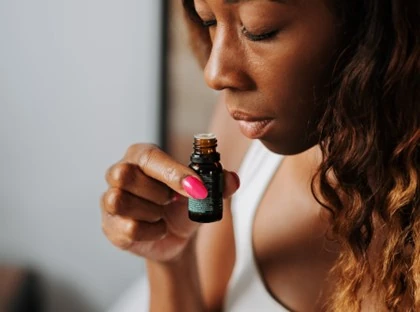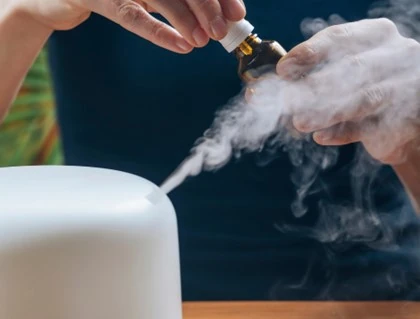Aromatherapy: Essential Oils to Support Your Health
Friday, June 21, 2024, 01:45 PM
This blog was originally published on October 11, 2018. It has been revised to include new information and links.
Aromatherapy (sometimes referred to as essential oil therapy) is an ancient practice that uses essential oils to promote physical and mental well-being.
Aromatherapy uses essential oils or oil blends to help improve symptoms associated with specific health concerns like:
- stress
- anxiety
- insomnia
- digestive issues
- depression
- chronic pain
- skin conditions
In this blog, we’ll delve into the history of essential oils, uncover how they are created, identify which essential oils are effective for specific ailments, and explore the best methods to apply them.

Understanding Aromatherapy
Essential oils are derived from aromatic plants (e.g., lemongrass, lavender, rose, jasmine, etc.) traditionally known for their healing properties. These plant extracts are either applied directly to the skin in a diluted form or used aromatically (inhaled or mixed in a diffuser). They can also be combined with massage oils for aromatherapy massage.
Although the sense of smell can influence the brain’s response to a bodily condition, it does not address the root cause of the condition. Essential oils can help manage symptoms, but they do not resolve the underlying problems that may be causing the issue, such as stress or trauma.
The term "aromatherapy" was coined in 1937 by Rene-Maurice Gattefosse, after treating a burn with lavender oil. This incident and discovery focused his attention on natural healing properties.
However, the use of essential oils to heal has ancient origins dating back thousands of years.
Ancient Beginnings
Ancient Egyptians have used aromatic oils as early as 4500 BC. They used essential oils in cosmetics (perfumes) and ointments, mixing different sources of herbal plants, such as aniseed, cedar, onion, myrrh, and grapes.
They also used extracted oils, specifically cedarwood oil (which has a preservative effect), for mummification.
How Essential Oils Are Created
Essential oils are natural oils produced from plants, spices, trees, flowers, and fruits. The extraction methods vary depending on the plant.
Distillation
Distillation is the most common extraction method. Plants are placed over boiling water, and steam pulls the oils out. The steam is then cooled and condensed back into the water, separating the essential oils, which are collected.
Expression
Expression is used to extract oils from citrus plants by placing the plant's outer skin under enough pressure to release a liquid. This liquid is then put through a rapidly rotating machine that separates the oil from the fruit's juice. Solvent Extraction
Solvent Extraction
Solvent Extraction is a method used for plant materials that yield low amounts of essential oil or delicate plants unable to withstand the pressure of steam distillation.
In this method, plants are soaked in solvents. The solvent draws out the fragrance and creates a liquid that is then processed several times to separate the oil from the rest of the liquid.

Aromatherapy for Pain Relief
Aromatherapy can help manage pain symptoms like headaches, muscle aches, and chronic conditions.
Common Essential Oils for Pain Relief
- Peppermint: Known for its cooling and analgesic (pain reliever) properties. It can alleviate headaches, muscle pain, tension, and joint pain.
- Eucalyptus: This oil has anti-inflammatory and pain-relieving properties, making it helpful for joint pain and respiratory issues.
- Rosemary: It helps improve circulation and reduce muscle soreness.
How to Use
Peppermint and eucalyptus oils are best used as topical applications. Mix a few drops of the oil with a carrier oil (e.g., coconut oil, jojoba oil, olive oil, etc.) and apply to the affected area. Add rosemary oil to a warm bath to soothe sore muscles and improve circulation.
Aromatherapy for Insomnia
Insomnia can severely impact your quality of life, but aromatherapy offers a natural way to improve sleep.
Common Essential Oils for Insomnia
- Lavender: This oil has sedative properties that can be used for relaxation, but it also has anti-inflammatory, anti-fungal, and antibacterial properties.
- Cedarwood: Helps relax the mind and body.
- Bergamot: This citrus oil can reduce stress and anxiety, promoting better sleep.
How to Use
Lavender oil can be diffused or used as a pillow spray to enhance sleep quality. Cedarwood and bergamot can also be combined in a diffuser to create a tranquil sleeping environment.
Aromatherapy for Immune Support
Strengthening your immune system is crucial, especially during cold and flu season. Certain oils can help boost your immune response.
Common Essential Oils for Immune Support
- Tea Tree: This oil has anti-microbial capabilities and can be used to clean wounds and fungal and bacterial infections.
- Lemon: Known for its cleansing properties, lemon oil is a potent anti-microbial and is often used as an air freshener or in household cleaners due to its scent. It can also be used as a topical anti-fungal and can increase mood and concentration by reducing anxiety.
- Oregano: Often used to fight off cold and flu infections, ease upset stomach, and relieve menstrual symptoms.
How to Use
Diffuse tea tree or oregano oil to purify the air and support respiratory health. Create a blend with lemon oil to use in diffusers or as a cleaning spray.
Aromatherapy for Digestive Issues
Digestive discomfort can be alleviated with suitable essential oils.
Common Essential Oils for Digestive Discomfort
- Ginger: Known for its anti-nausea and digestive aid properties.
- Peppermint: Helps relieve bloating, indigestion, and irritable bowel syndrome (IBS).
- Fennel: Supports digestion, treats stomach muscle spasms caused by IBS, and helps reduce gas and bloating.
How to Use
Dilute ginger or peppermint oil in a carrier oil and massage onto the abdomen. Inhale fennel oil to relieve nausea and support digestion.
Aromatherapy for Skin Conditions
Aromatherapy can also benefit your skin, offering solutions for common skin issues.
Common Essential Oils for Skin Conditions
- Tea tree: Can treat blackheads, dandruff, boils, and acne.
- Lavender: Its anti-fungal properties reduce inflammation, and it can help soothe eczema and dry skin.
- Frankincense: This oil helps protect skin cells. It can help reduce acne blemishes, prevent wrinkles, and tighten skin.
- Oregano: It can treat skin conditions like eczema, psoriasis, and rosacea.
How to Use
Always dilute essential oils with a carrier oil before applying them to the skin to avoid irritation. Test a small amount of diluted oil on your skin to check for harmful reactions.
Incorporate tea tree or oregano oil into your skincare routine. Use lavender or frankincense oil on specific areas to reduce inflammation and promote healing.
Speak to an Aromatherapy Practitioner
Aromatherapy offers a natural way to manage symptoms of some health conditions. However, essential oils are powerful and should be used carefully.
Only certain essential oils can be safely applied to the skin, and they should always be diluted with a carrier oil first. Some essential oils should not be exposed to the sun and should never be consumed.
We recommend speaking with your health care provider or an NHPC-recognized aromatherapy practitioner about essential oil safety, usage, and how best to incorporate them into your daily routine.

